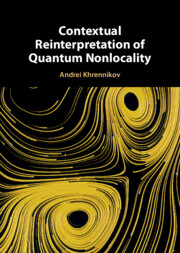Book contents
- Frontmatter
- Dedication
- Contents
- Preface
- Acknowledgments and Recollections
- 1 Introduction to Quantum Measurement Theory
- Part I Quantum Foundations
- 2 Two Faces of Quantum Nonlocality and Two Interpretations of Quantum State
- 3 Bohr’s Principle of Complementarity and Its Contextual Basis
- 4 Information Interpretations of Quantum Mechanics
- 5 Quantum Postulate as the Seed of the Complementarity Principle
- Part II Bell Inequalities
- Part III Contextuality: Mathematical Modeling and Interpretation
- Part IV Contextual Entanglement in Quantum and Classical Physics
- Part V Hertz, Boltzmann, Schrödinger, and de Broglie on Hidden Parameters
- Part VI Further Developments
- References
- Index
5 - Quantum Postulate as the Seed of the Complementarity Principle
from Part I - Quantum Foundations
Published online by Cambridge University Press: 28 November 2024
- Frontmatter
- Dedication
- Contents
- Preface
- Acknowledgments and Recollections
- 1 Introduction to Quantum Measurement Theory
- Part I Quantum Foundations
- 2 Two Faces of Quantum Nonlocality and Two Interpretations of Quantum State
- 3 Bohr’s Principle of Complementarity and Its Contextual Basis
- 4 Information Interpretations of Quantum Mechanics
- 5 Quantum Postulate as the Seed of the Complementarity Principle
- Part II Bell Inequalities
- Part III Contextuality: Mathematical Modeling and Interpretation
- Part IV Contextual Entanglement in Quantum and Classical Physics
- Part V Hertz, Boltzmann, Schrödinger, and de Broglie on Hidden Parameters
- Part VI Further Developments
- References
- Index
Summary
The hidden variable project realized by Bell contradicts the uncertaintyand complementarity principles. The inequalities derived with Bell’s hidden variablesare violated for quantum observables. Thus, Bell’s hidden variables shouldbe rejected and the validity of quantum theory is confirmed. (This foundationalachievement deserved the Nobel Prize in 2022.) This scientific loop,ignorance of the uncertainty and complementarity principles – hidden variablesmodel – Bell’s inequalities – their violation – reestablishing the validityof the uncertainty and complementarity principles, was stimulating for quantumfoundations. However, Bohr and Heisenberg might say that such resultscan be expected from the very beginning. For them, the uncertainty andcomplementarity principles form the basis of quantum physics. And theycan’t be rejected, since they are the consequences of the so-called quantum postulate– the existence of an indivisible quantum of action given by Planck’sconstant h. The quantum postulate is the ontological basis of quantum theory.I formulated its epistemic counterpart in the form of the principle ofquantum action invariance.
Keywords
- Type
- Chapter
- Information
- Contextual Reinterpretation of Quantum Nonlocality , pp. 52 - 56Publisher: Cambridge University PressPrint publication year: 2024

